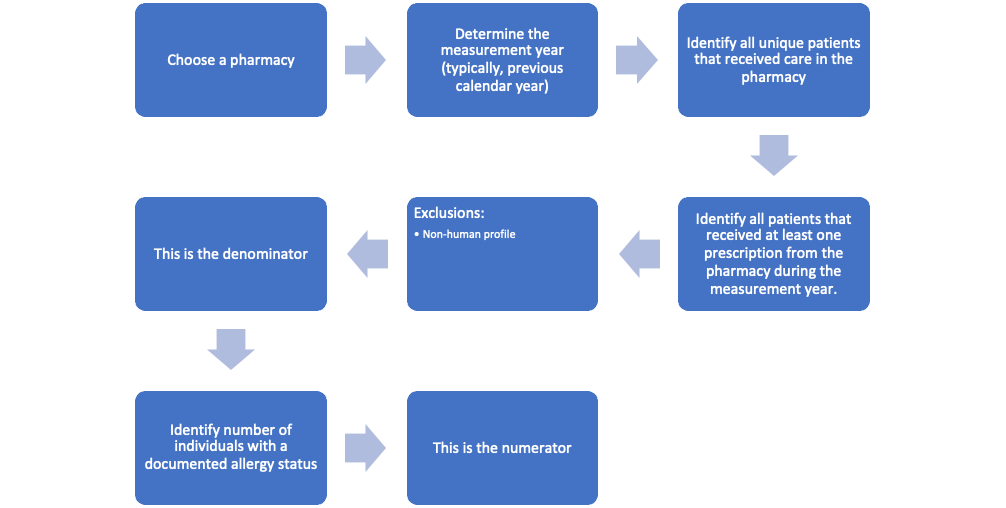Known Allergy Status
|
Title |
Known Allergy Status |
|
Description |
Percent of patient records with documented allergy status, including ‘no known drug allergies’.
A higher rate is better. |
|
Rationale |
Community pharmacies are the last step prior to a patient receiving a medication and last chance to verify drug allergies. |
|
Logic Model |
This measure ensures the pharmacy has the salient information (allergy history) to ensure patient specific dosing. |
|
Level of Analysis |
Pharmacy (Patient) |
|
Data Source |
Pharmacy Data |
|
Denominator Statement |
All individuals dispensed a prescription from the pharmacy during a measurement year |
|
Denominator Calculation |
1. 1. Identify all prescriptions in a measurement year 2. 2. Identify all unique patients from the prescriptions 3. 3. Apply exclusions |
|
Denominator Exclusions |
Any non-human patients (e.g., cats, dogs, clinics, office-use, etc) |
|
Denominator Exclusion Rationale |
Pharmacies may provide care to pets or other veterinarian needs, or for office-use. This patient profiles should be excluded from the measure calculation. |
|
Numerator Statement |
Individuals from the denominator with documented allergy status on record |
|
Numerator Calculation |
1. Number of individuals from the denominator with documented allergy |
|
Seguridad Measure Specification Process |
|
|
Data Stratification |
The measure rate will be reported as percent of patients within a single pharmacy.
If available and feasible, measure rate will be reported by type of pharmacy (e.g., health-system, community, specialty, mail-order, long-term care).
If available and feasible, measure rate will be reported by line of business (pharmacy Medicare rate, pharmacy Medicaid rate, pharmacy Commercial rate, and pharmacy uninsured rate).
Risk adjustment will be applied when available. |
|
Value Sets |
No value set is required for the calculation of this measure. |
|
Future Iterations |
Many pharmacy measures are designed as structure or process. Future goals of this concept include measures focused on updating the allergy status on an annual basis. |
|
Harmonization1 |
Payors: N/A Providers: N/A |
1. Measures that have either the same target populations (denominator) or the same measure focus (numerators) may be considered related, whereas measures that have the same targeted population (denominator) and same measure focus (numerator), are considered competing measures. Measures being developed should be harmonized, where feasible, to previously established measures to decrease measure burden. Choose My Pharmacy measures are developed for pharmacy evaluation, which is a novel area for measurement science, no current measure evaluates this level of analysis. Choose My Pharmacy measures will be harmonized to the extent possible, recognizing different levels of analysis have different data elements, and instead the focus will be to vertically integrate the Choose My Pharmacy measures with other measurement systems and measures.


No Comments